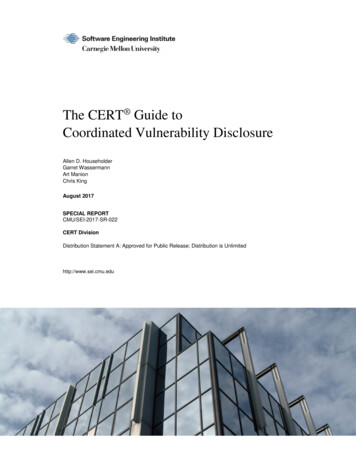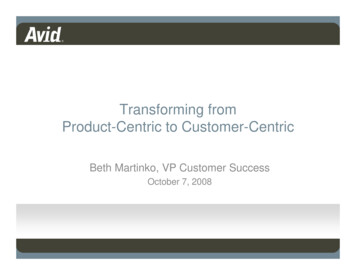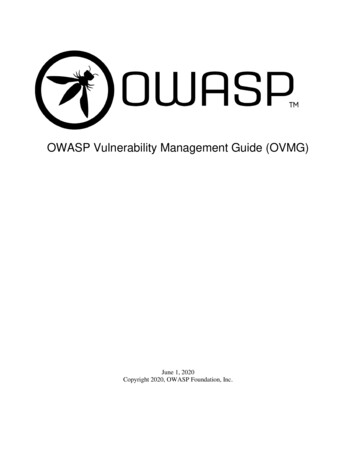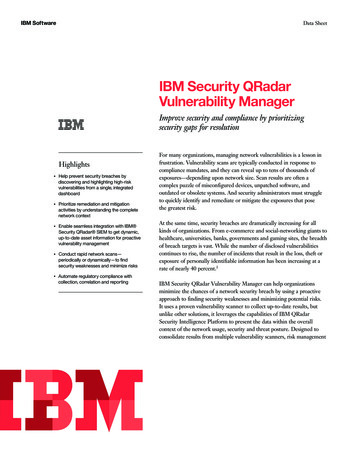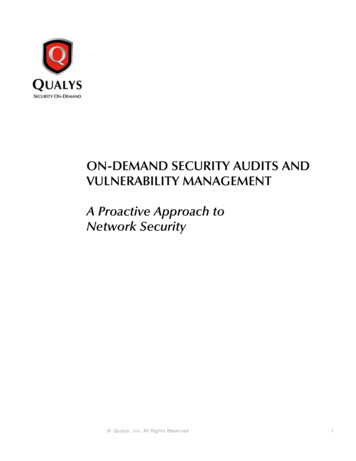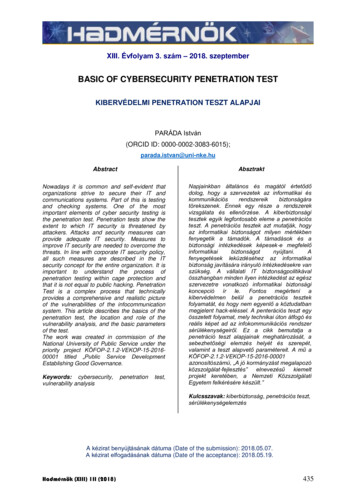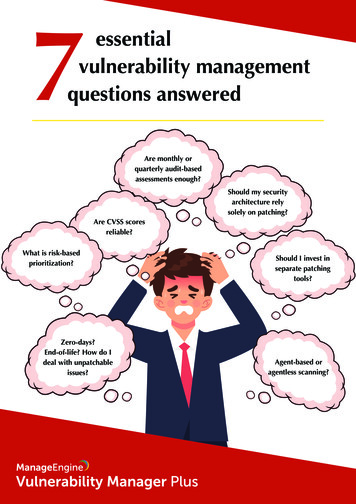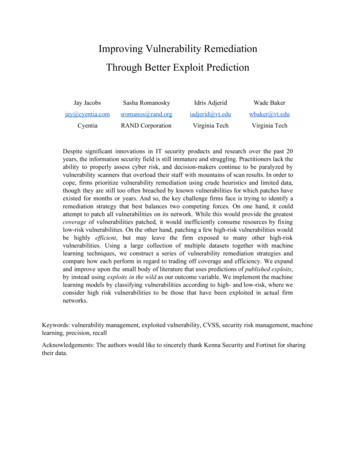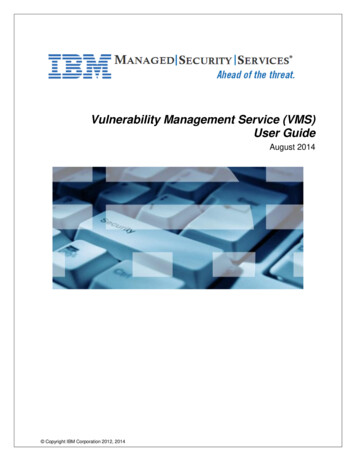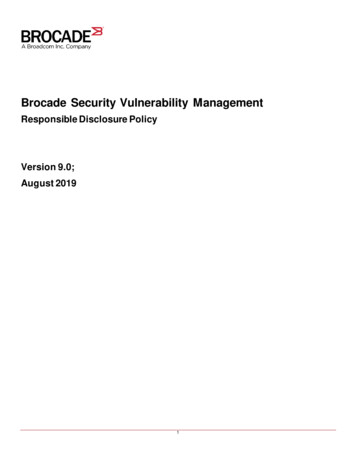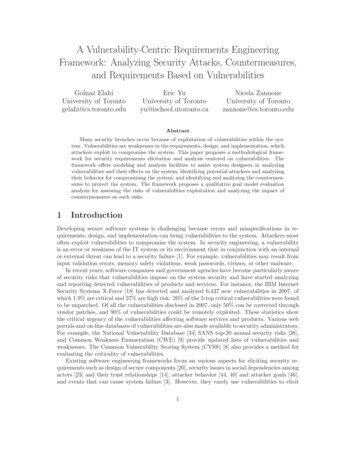
Transcription
A Vulnerability-Centric Requirements EngineeringFramework: Analyzing Security Attacks, Countermeasures,and Requirements Based on VulnerabilitiesGolnaz ElahiUniversity of Torontogelahi@cs.toronto.eduEric YuUniversity of Torontoyu@ischool.utoronto.caNicola ZannoneUniversity of Torontozannone@cs.toronto.eduAbstractMany security breaches occur because of exploitation of vulnerabilities within the system. Vulnerabilities are weaknesses in the requirements, design, and implementation, whichattackers exploit to compromise the system. This paper proposes a methodological framework for security requirements elicitation and analysis centered on vulnerabilities. Theframework offers modeling and analysis facilities to assist system designers in analyzingvulnerabilities and their effects on the system; identifying potential attackers and analyzingtheir behavior for compromising the system; and identifying and analyzing the countermeasures to protect the system. The framework proposes a qualitative goal model evaluationanalysis for assessing the risks of vulnerabilities exploitation and analyzing the impact ofcountermeasures on such risks.1IntroductionDeveloping secure software systems is challenging because errors and misspecifications in requirements, design, and implementation can bring vulnerabilities to the system. Attackers mostoften exploit vulnerabilities to compromise the system. In security engineering, a vulnerabilityis an error or weakness of the IT system or its environment that in conjunction with an internalor external threat can lead to a security failure [1]. For example, vulnerabilities may result frominput validation errors, memory safety violations, weak passwords, viruses, or other malware.In recent years, software companies and government agencies have become particularly awareof security risks that vulnerabilities impose on the system security and have started analyzingand reporting detected vulnerabilities of products and services. For instance, the IBM InternetSecurity Systems X-Force [18] has detected and analyzed 6,437 new vulnerabilities in 2007, ofwhich 1.9% are critical and 37% are high risk. 20% of the 5-top critical vulnerabilities were foundto be unpatched. Of all the vulnerabilities disclosed in 2007, only 50% can be corrected throughvendor patches, and 90% of vulnerabilities could be remotely exploited. These statistics showthe critical urgency of the vulnerabilities affecting software services and products. Various webportals and on-line databases of vulnerabilities are also made available to security administrators.For example, the National Vulnerability Database [34] SANS top-20 annual security risks [38],and Common Weakness Enumeration (CWE) [9] provide updated lists of vulnerabilities andweaknesses. The Common Vulnerability Scoring System (CVSS) [8] also provides a method forevaluating the criticality of vulnerabilities.Existing software engineering frameworks focus on various aspects for eliciting security requirements such as design of secure components [20], security issues in social dependencies amongactors [23] and their trust relationships [14], attacker behavior [44, 40] and attacker goals [46],and events that can cause system failure [3]. However, they rarely use vulnerabilities to elicit1
security requirements. Liu et al. [23] propose a vulnerability analysis approach for elicitingsecurity requirements. However, vulnerabilities in this framework are different from the onesdefined in security engineering (i.e., weaknesses in the IT system). Liu et al. refer to vulnerabilities as the weak dependencies that may jeopardize the goals of depender actors. Only fewsecurity software engineering approaches consider analyzing vulnerabilities, as weaknesses in thesystems, during the elicitation of security requirements. For instance, in [27], vulnerabilities aremodeled as beliefs inside the boundary of attackers that may positively contribute to attacks.However, the resulting models do not specify which actions or assets introduce vulnerabilitiesinto the system, and which actors are vulnerable. In addition, the impact of countermeasures onvulnerabilities and attacks is not captured. The CORAS framework [5, 12] provides a way forexpressing how a vulnerability leads to another vulnerability and how a vulnerability (or combination of vulnerabilities) lead to a threat. However, similar to [27], CORAS does not investigatewhich design choice, requirement, or process has brought the vulnerabilities to the system.Current state of the art raises the need for a systematic way to link the empirical securityknowledge such as information about vulnerabilities, attacks, and proper countermeasure tostakeholders’ goals and security requirements. By identifying vulnerabilities or classes of vulnerabilities and associating them with the activities and assets that bring them to the system,analysts can understand how weaknesses are brought to the system and how flaws in one partof the system are spread out to other parts. Information about potential attacks that exploitvulnerabilities can be linked to requirements to analyze the effects of the exploited vulnerabilitieson activities or goals of stakeholders. Analyzing the effects of vulnerabilities on the system makesit possible to assess the risks of attacks, analyze the efficacy of countermeasures, and decide onpatching or disregarding the vulnerabilities. In our previous work [13], we have introduced vulnerabilities into a security conceptual modeling method to address these issues. Vulnerabilitiesare treated as weaknesses in the structure of goals and activities of intentional agents. However,vulnerabilities were only graphically attached to the i* modeling elements, while the semanticsof vulnerabilities relationships with other elements of the i* models were not well defined. Inaddition, vulnerability analysis was not complemented with a threat analysis.This paper extends and refines our previous work by proposing an agent- and goal-orientedframework for eliciting and analyzing security requirements by linking empirical knowledge ofvulnerabilities to requirements models. In particular, we have revised the modeling frameworkproposed in [13] on the basis of a conceptual framework centered on vulnerabilities. This conceptual framework helps us identify the basic constructs and relationships necessary to model andanalyze vulnerabilities and their effects on the system, and define their semantics. The proposedvulnerability-centric security requirements framework is the result of surveying current criticalvulnerabilities in security engineering discipline to understand how vulnerabilities are broughtto the system, exploited by the attacks, and handled by the countermeasures.Together with a modeling framework this paper proposes a goal model evaluation method thathelps analysts verify whether top goals of stakeholders are satisfied with the risk of vulnerabilitiesand attacks and assess the efficacy of security countermeasures against such risks. The evaluationdoes not only specify if the goals are satisfied, but also makes it possible to understand why andhow the goals are satisfied (or denied) by tracing back the evaluation to vulnerabilities, attacks,and countermeasures. In addition, the resulting security goal models and goal model evaluationcan provide a basis for trade-off analysis among security and other quality requirements [13].New vulnerabilities are continuously being uncovered. By linking requirements, vulnerabilities,and countermeasures to each other in a modeling framework, one can update the models withnewly detected vulnerabilities in order to analyze the risks imposed by the new vulnerabilities.The structure of the paper is organized as follows. Section 2 introduces the security concepts used in the paper with a particular focus on vulnerabilities and related notions. Section 3introduces the meta-model of the framework, in which security concepts are incorporated intoan agent- and goal-oriented modeling framework. Section 4 describes the modeling process, andSection 5 proposes a method for analyzing security requirements based on the goal model evalua2
tion techniques. The modeling and analysis methods described are illustrated by case examples.Section 6 overviews the current state of the art in threat analysis and security requirementsengineering. Finally, Section 7 draws a conclusion and discusses future work.2Relevant ConceptsThis section investigates the conceptual foundation for the security requirements engineeringframework proposed in this paper. We identify and discuss the basic security conceptual modelingconstructs that we have adopted in the meta-model of our framework (Section 3). This discussionis grounded in the security engineering literature.An asset is “anything that has value to the organization” [19]. Assets can be people, information, software, and hardware [12]. They can be the target of attackers and, consequently, needto be protected. Assets such as software products, services, and data, may have vulnerabilities.A vulnerability is a weakness or a backdoor in the IT system which allows an attacker to compromise its correct behavior [1, 39, 36]. Identifying which are the vulnerabilities of the systemand which assets have brought them into the system help analysts to analyze how vulnerabilitiesspread within the system and, consequently, to determinate the vulnerable components of thesystem.The potential way an attacker can violate the security of (a component of) the IT system iscalled threat (or attack ) [41]. Essentially, an attack is a set of intentional unwarranted actionswhich attempts to compromise confidentiality, integrity, availability, or any other desired featureof an IT system. Though the general idea of attack is clear, there is no consensus on a precisedefinition. For instance, Schneider [39] points out that an attack can occur only in presence ofa vulnerability. Conversely, Schneier [41] broadens this vision, considering also attacks that canbe performed without exploiting vulnerabilities. Several frameworks for security analysis takeadvantage of temporally-ordered models for analyzing attacks [32, 35]. Incorporating the concept of time into the attack modeling helps to understand the steps of actions and vulnerabilityexploitations which lead to a successful attack. However, temporally-ordered models add complexity to the requirements engineering models which may not be suitable for the early stagesof development.Analyzing attacks and vulnerabilities allows analysts to understand how system security canbe compromised. Another aspect to be considered are attackers’ motivations (malicious goals).Examples of malicious goals are disrupt or halt services, access confidential information, andimproperly modify the system [4]. Schneier [40] argues that understanding who the attackers arealong with their motivations, goals, and targets, aids designers in adopting proper countermeasures to deal with the real threats. Analyzing the source of attacks helps to better predict theactions taken by the attacker.Threat analysis attempts to identify the types of threats that an organization might beexposed to and the harm they could cause to the organization (i.e., the severity of threats).Threat analysis starts with the identification of possible attackers, evaluates their goals, andhow they might achieve them. Through threat assessment, analysts can assess the risk and costof attacks and understand their impact on system security.Such knowledge helps analysts in the identification of appropriate countermeasures to protectthe system. A countermeasure is a protection mechanism employed to secure the system [41].Countermeasures can be actions, processes, devices, solutions, or systems intended to prevent athreat from compromising the system. For instance, they are used to patch vulnerabilities orprevent their exploitation.Besides the concepts described above, there are other concepts relevant to security requirements. For instance, Massacci et al. [24] integrate concepts from trust management, such aspermission, trust and delegation, into a requirements engineering framework to address authorization issues in the early phases of software development process. Risk analysis frameworks3
(e.g., [3]) employ the concepts of event to model uncertain circumstances that affect the correctbehavior of the system. However, events do not allow the analysis of (malicious) intentional behavior and, therefore, they result more appropriate to assess risks and elicit safety requirementsin critical systems.Security is not only limited to the identification of protection mechanisms to address vulnerabilities. Security originates from human concerns and intents [23]; the social issues of organizations where different actors can collaborate or compete to achieve their goals should beconsidered as part of security requirements analysis [14, 23]. In addition, security is a subjectiveand personal feeling [42]; therefore, security requirements analysis and security-related decisionmakings require analyzing personal and organizational goals of the stakeholders participating tothe system. For this purpose, we take advantage of agent- and goal-oriented concepts such asintentional actor, goal, and social dependency. There is evidence in the security requirementsengineering literature (e.g., [14, 23, 25, 46]) that these concepts provide the means for analysisof organizational and social contexts in which the system-to-be operates. In the next section, weshow how security concepts can be integrated in the meta-model underlying the i* agent- andgoal-oriented framework.3An extended i* Meta-ModelSecurity is both a technical and a social/organizational problem. The ability of the i* framework[50] to model agents, goals, and their dependencies makes it suitable for understanding securityissues that arise among multiple malicious or non-malicious agents with competing goals. Inaddition to modeling actors, i* offers a way to model actors’ dependencies, goals, assets, andactions, refinements of goals into the actions and assets, and decomposition of actions. Thus,the i* framework provides the basic setting for representing vulnerabilities that are broughtby actions and assets and propagating them through the decomposition and dependency linksto other elements of model. Moreover, i* enables modeling contribution of goals, actions, andassets on other goals. Such relations can be used to capture the effects of vulnerabilities on thesatisfaction of system and stakeholders’ goals.In this section, we present the meta-model for the security requirements engineering framework, which extends the i* meta-model with security concepts (Figure 1). The meta-modelincludes both the i* Strategic Dependency (SD) diagram, which captures the actors and theirdependencies and the i* Strategic Rationale (SR) diagram, which expresses the internal goalsand the behavior of actors to achieve their goals. The meta-model also captures the conceptsof vulnerability, attack, security countermeasure, and their corresponding relationships with i*constructs.3.1The i* Meta-ModelThis section provides an overview of the i* framework’s meta-model along the modeling constructs it provides (Figure 1). An actor is an active entity that has strategic goals and intentionality within the system or the organizational setting, carries out activities, and produces entitiesto achieve goals by exercising its knowhow [50]. Actors can be roles or agents. A role capturesan abstract characterization of the behavior of a social actor within some specialized context ordomain of endeavor. An agent is an actor with concrete and physical manifestations and canplay some role.Intentional elements defined by the i* framework are goals, softgoals, tasks, and resources.A goal represents the intentional desire of an actor, without specification of how the goal issatisfied. Goals are also called hard goals in contrast to softgoals which do not have clear criteriafor deciding whether they are satisfied or not. A task is a set of actions which the actor needs4
Figure 1: The i* meta-model extended with the concept of vulnerability and attackto perform to achieve a goal. A resource is a physical or an informational entity and is used torepresent assets.The relations between actors are captured by the notion of dependency. Actors can dependon each other to achieve a goal, perform a task, or furnish a resource. For example, in a goaldependency, an actor (the depender ) depends on another actor (the dependee) to satisfy thegoal (the dependum). In addition to the dependum, two other intentional elements are involvedin a dependency. One element represents why a depender needs the dependum, and the otherelement specifies how the dependee satisfies the dependum.The meta-model in Figure 1 also describes the relationships between intentional elementsinside the boundary of actors. Actors have (soft)goals and rely on other (soft)goals, tasks, andresources to achieve them. Softgoals can be decomposed into more softgoals using AND/ORdecomposition relations. Means-end links are relations between goals and tasks, and indicatethat a goal (the end ) can be achieved by performing alternative tasks (the means). Taskscan be decomposed into any other intentional elements through task decomposition links. Bydecomposing a task into sub-elements, one can express that the sub-elements need to be satisfiedor available to have the root task performed.Softgoals and other intentional elements can contribute either positively or negatively tothe other softgoals. This is expressed by the contribution links. The contribution relation ischaracterized by an attribute type which can be Help ( ), Make ( ), Hurt ( ), Break ( )and Unknown (?) values. By linking an intentional element to a softgoal by a Make (Break)contribution, one can express that satisfaction of the intentional element is enough to fully satisfy(fully deny) the softgoal, while Help (Hurt) contributions indicate that the intentional elementhas positive (negative) impact, but the impact is not enough to fully satisfy (deny) the softgoal.This qualitative approach for modeling contribution to softgoals reflects the fact that softgoalsdo not have clear-cut satisfaction criteria.5
3.2Attack and Security Countermeasure Extensions to the i* MetaModelThe concepts of vulnerability, attacks, effects of vulnerabilities, and impact countermeasures areadded to the i* meta-model. In Figure 1, extended elements to the i* meta-model are highlighted. Adopting a task or employing a resource can bring vulnerabilities to the system. Theconcept of vulnerability is not limited to specific reported vulnerabilities or to general classesof vulnerabilities. For example, one can model the famous worm called 2000 ILOVEYOU 1 orgeneral class of argument injection or modification. For the sake of simplicity, we call an intentional element that introduce a vulnerability a vulnerable element. Vulnerabilities are concreteweaknesses or flaws that exist in a component of the system like a process, asset, algorithm, andplatform, whereas goals and softgoals represent actors’ intentions and software quality attributesrespectively. In the i* conceptual framework, adopting a task or employing a resource describes aconcrete way of achieving a (soft)goal; therefore, (soft)goals which are abstract and independentof operationalization, do not introduce a flaw or vulnerability.Exploitation of vulnerabilities can have an effect on the same element that has brought thevulnerabilities or on other tasks, goals, and resources. The effect is characterized by an attribute,type, which specifies how the vulnerability affects a goal, a task, or a resource. The effect typesare Hurt ( ), Break ( ), and Unknown (?). The effect of vulnerabilities on softgoals is notconsidered in the meta-model, since softgoals are not directly-measurable goals. The effect ofvulnerabilities would be propagated to softgoals from the affected elements that contribute tothe softgoals.An attack represents the set of actions that an attacker performs to exploit a number ofvulnerabilities and has negative effects on other intentional elements. In Figure 1, we use anaggregation relation to indicate the tasks, actors, vulnerabilities, and their effects are assembledand configured together to mount an attack. This definition of attacks is based on the definitionproposed by Schneider [39] in which vulnerabilities are a key aspect of any attack. This choiceis due to the fact that we are mainly interested in analyzing the effects of vulnerabilities onthe system. Attacks that are performed without exploiting vulnerabilities can be modeled byintroducing a new class of attacks in which their target is a task or a resource instead of a set ofvulnerabilities.Resources and tasks can have a security impact on attacks. Such tasks and resources canbe interpreted as security countermeasures; however, we do not distinguish them from nonsecurity mechanisms in the meta-model as this distinction does not affect the requirementsanalysis. The impact relation has the attribute, type, which accepts Hurt ( ), Break ( ), andUnknown (?) values. Security countermeasures can be used to patch vulnerabilities, alleviatethe effect of vulnerabilities, or prevent the malicious tasks that exploit vulnerabilities or systemfunctionalities.By patching the vulnerability, the countermeasure fixes the weakness in the system. Exampleof such countermeasure is new updates the software vendors provide for the released products.A countermeasure that alleviates the vulnerability effects does not address the source of theproblem, but it intends to reduce the effects of the vulnerability exploitation. For example, abackup system mitigates the effect of security failures that cause data loss. Countermeasurescan prevent the actions that the attacker performs, which consequently prevents exploitation ofthe vulnerability by the actions. For example, an authentication solution prevents unauthorizedaccess to assets. Countermeasure may prevent performing vulnerable tasks or prevent usingvulnerable resources, which results in removing the vulnerability that has been brought to thesystem by the vulnerable elements. For example, one can disable JavaScript option in thebrowser to prevent exploitation of malware run by the browser. Countermeasures can also havean impact on (soft)goals. However, such an impact is different from security impact and is1 http://www.cert.org/advisories/CA-2000-04.html6
Figure 2: A fragment of the meta-model in which attacks, attackers, malicious behavior, andsecurity countermeasure are explicit elements of the meta-modelcaptured through relationships such as means-end, decomposition, and contribution relations,which are embedded in the i* meta-model.The definition of attack and security countermeasure is fundamentally a matter of perspective: a task or a goal counted as malicious can be perceived non-malicious from a differentviewpoint. Sequences of actions for mounting an attack are basically similar to sequences ofactions performed by legitimate actor. Therefore, the line to differentiate malicious actions fromnon-malicious ones is arbitrary, and distinguishing malicious goals from non-malicious goals depends on the perspective adopted by the system designer.Malicious elements have the same semantics of ordinary intentional elements: they can besimilar or identical to non-malicious elements. For example, the desire to have a high profit isnot a malicious goal, but an actor can achieve such a goal either by working legally and honestlyor cheating. On the other hand, a task can be interpreted as malicious in a condition while it iscounted as non-malicious in a different context. For example, one can install a camera for spyinginto other people privacy, whereas a surveillance camera can be used for security purposes. Inthis example, the goal for performing tasks indicates if the task is malicious or not.Since malice is a matter of perspective, distinguishing malicious and non-malicious behaviordoes not affect security requirements analysis. Therefore, the meta-model presented in Figure 1 isa neutral meta-model that does not distinguish malicious and non-malicious elements. However,as showed by Sindre and Opdahl [45], graphical models become much clearer if the distinctionbetween malicious and non-malicious elements is made explicit and the malicious actions arevisually distinguished from the legitimate ones. Sindre and Opdahl show that the use of invertedelements strongly draws the attention to dependability aspects early on for those who discussthe models. In this regard, an extended meta-model is developed with the assumption thatsome actors are attackers and have malicious goals, and other actors employ countermeasuresfor protecting their goals. Figure 2 presents the extended meta-model, which is derived fromthe meta-model in Figure 1 by introducing a new type of actor called attacker. An attacker is7
a specialization of the i* actor elements; thus, the same modeling rules and properties of the i*actors can be applied for modeling attackers. In particular, as for actors, attackers can be rolesand agents. Attackers have malicious intentional elements such as malicious goals and malicioussoftgoals inside its boundary. The concept of boundary is added to link the malicious elementsto the attacker. An attack involves an attacker, malicious tasks that he performs to exploit a setof vulnerabilities, and the effect of exploited vulnerabilities on other actors’ intentional elements.4The Modeling ProcessThis section presents the security requirements modeling process along with the modeling notation and graphical representation. The resulting models help analysts to understand the socialand organizational dependencies among main stakeholders of the system, their goals, the systemarchitecture, the organization structure [50], and security issues that arise among interaction ofactors [13] in the early stages of the development.Figure 3 summarizes the modeling process. The process consists of five steps; each of themresults in a view of the security requirements model. Each of these views provides additionalincremental information:1. Requirements view captures stakeholders and system actors together with their (soft)goals,the tasks to achieve those goals, required resources, and the dependencies among them.2. Vulnerabilities view extends the requirements view by adding the vulnerabilities that tasksand resources brings to the system and the impact that their exploitation (or of theircombinations) has on the system.3. Attackers template view captures the behavior of attackers by representing how attackerscan exploit vulnerabilities to compromise the system.4. Attackers profile view captures individual goals, skills, and behavior of a specific class ofattackers based on the attacker template view.5. Countermeasures view captures the security solutions adopted by actors to protect thesystem and their impacts on attacks and vulnerabilities.The process for developing security requirements models is incremental: in each step newelements are added to the requirements model to show new aspects. The modeling processstarts with the identification of actors, their dependencies, goals, and the tasks and resourcesnecessary to achieve them. Then, vulnerabilities are identified and propagated through the goalmodel. In the third step, possible attacks that can exploit the vulnerabilities are identified andanalyzed. Attacker profiles that specify the capabilities and skills of categories of attackers aredefined. The model is then evaluated to assess the risks of exploitation of vulnerabilities byattackers. If the analysis shows that the risks cannot be tolerated by stakeholders, the requirements model is revised by introducing countermeasures and their impacts on vulnerabilities andattacks. Modeling goal, vulnerabilities, attacks, and countermeasures is an iterative process asthe adoption of countermeasures may cause the introduction of new vulnerabilities as well asdenial of functionalities or quality goals.Identification of vulnerabilities, attacks, and countermeasures requires security knowledgeand experience. A main assumption of this work is that analysts have the security experience and knowledge necessary to identify vulnerabilities or extract them from vulnerabilitiesknowledge bases. The proposed framework does not provide guidelines or methods for findingvulnerabilities and attacks and identifying proper countermeasures. It proposes a way for linkingsecurity knowledge such as reports of attacks, list of vulnerabilities, and alternative countermeasures, to requirements and provide support for security requirements analysis. Analysts can take8
Figure 3: The modeling processadvantage of available vulnerability knowledge sources such as the CWE categorization of weaknesses and vulnerabilities [9], SANS list of top-20 vulnerabilities [38], and CVE entries [8]. CVEcontains vendor-, platform- and product-specific vulnerabilities. Such technology- and systemoriented vulnerabilities are not useful to decide on security requirements in the early stages ofdevelopment where target platform and technology is not yet decided. SANS list and CWE catalog include more abstract weaknesses, errors, and vulnerabilities. Some entries in these lists aretechnology and platform independent, while others are specific to specific products, platforms,and programming languages.4.1Eliciting and Modeling Initial RequirementsRequirements modeling intends to identify and model stakeholders’ needs and system requirements. We take advantage of the i* framework that provides a way for modeling and analyzingstakeholders’ and system’s goals and system-and-environment alternatives that address achievements of the goals [51, 50]. We do not
which 1.9% are critical and 37% are high risk. 20% of the 5-top critical vulnerabilities were found to be unpatched. Of all the vulnerabilities disclosed in 2007, only 50% can be corrected through . the National Vulnerability Database [34] SANS top-20 annual security risks [38], and Common Weakness Enumeration (CWE) [9] provide updated lists .
